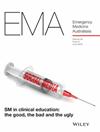Frequent attendance to paediatric emergency departments: Steps towards prevention
Abstract
Objective
To improve understanding of sociodemographic characteristics, underlying medical conditions, and healthcare factors contributing to persistent frequent attendance to paediatric emergency departments (PED), and to explore opportunities for prevention.
Methods
A retrospective review of patients attending a PED >5 times per year for 2 years (persistent frequent attendance) was conducted with an analysis of sociodemographic characteristics, underlying health conditions, PED attendance factors, and evidence of General Practitioner (GP) continuity of care.
Results
Seventy-two paediatric patients (0.1% of PED patients) attended the PED frequently for two consecutive years (median 18.5 visits) accounting for 1.9% (n = 1914) of total PED presentations. Of these patients, 55.6% resided in disadvantaged areas, 13.8% were Aboriginal people and 52.8% had an identified GP. 100% had chronic health conditions. 40% had primarily medical conditions (median age 4.6 years) and 33.3% had primarily mental health conditions (median 15.8 years). 26.4% of patients had co-morbid chronic mental health and medical conditions (median 16.4 years) and attended the most frequently (median 33.0 presentations). Of the two groups with chronic mental health conditions, 55.8% of patients were under Guardianship (Child Protection Services).
Conclusions
Chronic health conditions, socio-economic disadvantage, child protection involvement, Aboriginal background, and lack of GP continuity contribute to persistent frequent PED attendance. Preventative strategies that increase community support and improve the underlying health and wellbeing of patients experiencing, or at risk of, frequent PED attendance would be beneficial for patients, caregivers, and clinicians. Research exploring frameworks that connect these patients with GPs for continuity of care is recommended.

 求助内容:
求助内容: 应助结果提醒方式:
应助结果提醒方式:


